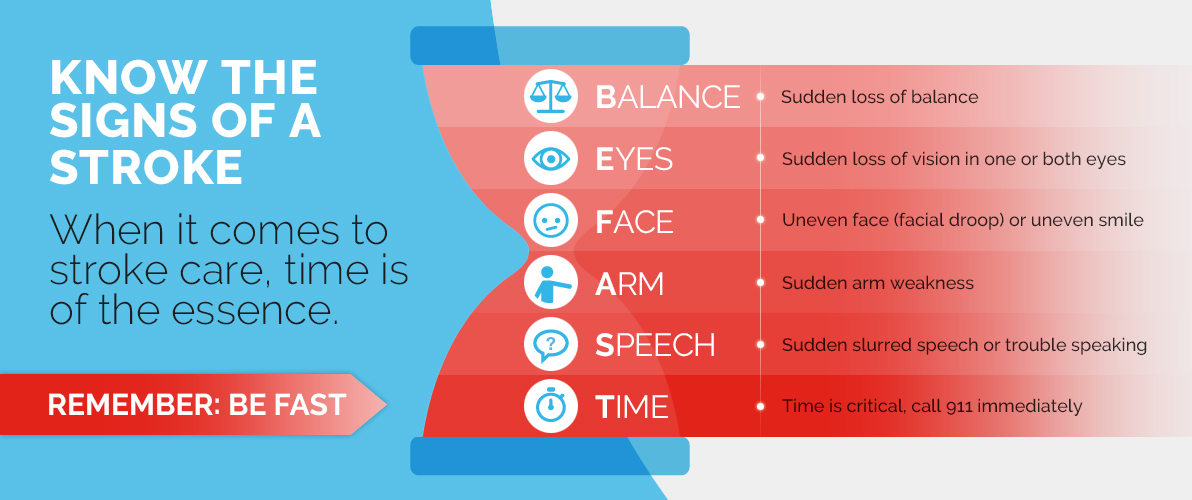Understanding Stroke Guidelines and How to Prevent Stroke in Women
NewYork-Presbyterian neurologists explain the signs and symptoms of a stroke and how to prevent stroke in women.

Around 600,000 people in the United States have a stroke every year, and nearly 200,000 have a recurrent one. But the good news is that they are preventable 80% of the time, and new stroke guidelines from the American Stroke Association share ways on how to prevent them, especially stroke in women, who are at higher risk than men.
Over their lifetime, one in five women between the ages of 55 and 75 will have a stroke and about 57% of stroke deaths occur in women. To help address this, the guidelines provide sex-specific prevention recommendations.
“The guidelines list several factors that can increase the risk for stroke, especially in women, such as having high blood pressure, adverse pregnancy outcomes, endometriosis, and early menopause,” says Dr. Eliza Miller, a neurologist at NewYork-Presbyterian/Columbia University Irving Medical Center who specializes in women’s cerebrovascular health. “Certain risk factors affect women differently than men, and there are larger social factors that impact communities of color. When you add these things up, women, especially young and Black women, assume a higher risk of stroke over their lifetime.”
“If you have risk factors for stroke, it is important to address and control them with your care team,” says Dr. Olajide Williams, a neurologist at NewYork-Presbyterian/Columbia University Irving Medical Center. “Strokes associated with pregnancy, for example, can nearly triple the risk of stroke in women. We see folks who are pregnant who develop complications that increase the risk for stroke like high blood pressure, gestational diabetes, and pre-eclampsia.”
Health Matters spoke with Dr. Miller and Dr. Williams to understand why stroke risk is higher in women, what can lead to a stroke, and what people can do to prevent a stroke.

Dr. Eliza Miller
Why are women more at risk for stroke than men?
Dr. Eliza Miller: One of the main reasons the risk of stroke is higher in women than in men is because women on average live
longer, and age remains one of the huge risk factors for stroke. The longer you live, the more time you have to have a stroke. The higher lifetime prevalence of stroke in women has often been attributed to that fact. However, in younger age groups, especially under age 45, it is women who have a higher risk, especially during their reproductive years.
Why are Black women at even greater risk of stroke?
Dr. Olajide Williams: Studies have found that Black women who develop high blood pressure before the age of 35 may have triple the risk of having a stroke, and have twice the risk of having one if they are diagnosed with high blood pressure before age 45.
The new guidelines provide an orientation to social determinants of health and how these factors impact access to care and treatment of stroke risk factors. It highlights the importance of implementing screening in communities where there might be lower access to care such as communities with a high level of under-insured or uninsured people. By meeting people where they are, we can identify these risk factors much earlier and prevent a stroke. High blood pressure tends to be silent – so many people do not have symptoms.

What else can increase the risk of stroke in women?
Dr. Miller: Hormonal contraception that contains estrogen can increase the risk of blood clotting events, and therefore increase the risk of stroke, the guidelines also note. On its own, the risk from this kind of contraception is quite low. But if there are other risk factors, such as smoking, high blood pressure or migraines with aura — meaning someone experiences migraine headaches along with flashes of light or sparkling zigzags in their vision — then taking estrogen-containing contraceptives can further elevate the risk of stroke.
Some risk factors for stroke are simply more common in women. Women are more likely to experience depression, which raises your risk. Autoimmune conditions like lupus and antiphospholipid syndrome are more prevalent in women, and any condition that raises your level of inflammation is also going to increase your risk of stroke. For women with these conditions and who do not have a history of stroke, the guidelines recommend antiplatelet therapy, such as aspirin. However, people should always discuss with their doctor before starting aspirin.
It is important for young women and Black women to get holistic care during their reproductive years. This includes checking and managing blood pressure, cholesterol, and discussing with their doctor other factors that can impact someone’s cardiovascular health, particularly related to contraceptives and pregnancy.
Are trans women also at higher risk of stroke?
Dr. Miller: Trans women who take hormones have a higher risk of stroke compared to both cisgender women and men. But there are a lot of factors at play, not just hormone therapy. Some trans women may not be able to access hormone therapy from a doctor, they may not take the right dosage, and they may not seek care due to stigma.
If someone sees a doctor who has experience working with trans women and who can help address other stroke risk factors in addition to the hormones, there is no reason to stop hormone therapy. Transitioning from male to female is safe when you address other stroke risk factors.
What are types of strokes? Are there ones that are more common in young women?
Dr. Williams: There are many different types of strokes but there are two major ones. There is an ischemic stroke, which is when there is a blockage or occluded the blood vessel. The blood cannot get to the area of the brain that needs it. Another common one is a hemorrhagic stroke, which is when there is bleeding in the brain because an artery burst. The ischemic stroke is the most common — about 85% of strokes are of the ischemic type. A study published in the journal Stroke found that women 35 years and younger are 44% more likely to experience this type of stroke compared to men the same age.
But young people are vulnerable to all types of strokes. We are seeing a rise in stroke among young people due to the obesity epidemic, which heads to more diabetes, more high blood pressure, less physical activity, all of which are risk factors for stroke.

What are the signs and symptoms of a stroke?
Dr. Williams: Think of it as the acronym BE FAST. B stands for sudden loss of balance and E is for eyes, such as having sudden visual deficits or problems seeing through one or both eyes. F stands for face, such as having facial droop, or asymmetry of your face to one side. A is arm – when your arm is weak on one side typically or you cannot elevate it, or it drops when you lift it up. You cannot keep it up for more than a couple of seconds. S is for speech. You have some type of speech disturbance that also occurs suddenly such as slurring of your words, the use of incomprehensible words, or the inability to find words. All of these signs and symptoms occur suddenly. Then T stands for time, which means that it is time to call 911.
How to Prevent a Stroke
Some risk factors for stroke cannot be controlled, like age, family history, race, sex, or gender. But there are u003ca href=u0022https://www.cdc.gov/stroke/prevention.htmu0022 target=u0022_blanku0022 rel=u0022noreferrer noopeneru0022u003emany stepsu003c/au003e people can take to help prevent a stroke. The stroke guidelines suggest the following:u003cbru003eu003cbru003eu003cstrongu003eEat Healthy. u003c/strongu003eAvoid processed foods, excess salt, and excess sugar, including sweetened beverages. Rather, eat plenty of fruits and vegetables, nuts, and lean protein, like fish and skinless poultry. The guidelines recommend people with no prior history of cardiovascular disease, as well as those with high or intermediate risk adhere to the u003ca href=u0022https://healthmatters.nyp.org/why-doctors-recommend-the-mediterranean-diet-and-how-to-make-it-a-way-of-life/u0022u003eMediterranean dietu003c/au003e, especially adding in nuts and olive oil, which has been found to reduce the risk of stroke.u003cbru003e u003cbru003eu003cstrongu003eExercise.u003c/strongu003e Engage in regular moderate to vigorous physical activity. The American Heart Association recommends at least 150 minutes of moderate intensity aerobic exercise, such as riding a bike, jogging or playing tennis, each week.u003cbru003e u003cbru003eu003cstrongu003eMaintain a healthy weight. u003c/strongu003eKnowing your waist circumference and body mass index – a numeral value of your weight in relation to your height – can help you determine whether you are in a healthy weight range.u003cstrongu003e u003c/strongu003eu003cbru003e u003cbru003eu003cstrongu003ePrioritize Sleep.u003c/strongu003e u003ca href=u0022https://www.cnn.com/2023/04/05/health/sleep-problems-stroke-study-wellness/index.htmlu0022u003ePoor sleepu003c/au003e can raise your blood pressure and cause you to feel exhausted and hungry, which can lead to weight gain and increased risk of stroke. Adults need seven to nine hours of sleep each night. If you have issues with sleep, talk with your doctor to help address them.u003cbru003e u003cbru003eu003cstrongu003eDon’t smoke.u003c/strongu003e Smoking increases the risk of stroke; the risku003ca href=u0022https://www.nih.gov/news-events/news-releases/nih-study-links-cigarette-smoking-higher-stroke-risk-african-americansu0022u003e more than doublesu003c/au003e for African Americans who smoke compared to their nonsmoking peers.u003cbru003e u003cbru003eu003cstrongu003eMonitor and manage blood pressure. u003c/strongu003eBlood pressure levels less than 120/80 are optimal, according to AHA. High blood pressure is defined as having numbers 130 or above (as the top number) or 80 or above (as the bottom number). Ensuring optimal blood pressure, which can be determined during doctor visits, can help you stay healthier for longer and reduce the risk of cardiovascular disease and stroke.u003cbru003eu003cstrongu003e u003c/strongu003eu003cbru003eu003cstrongu003eMonitor and manage blood sugar. u003c/strongu003eMost of the food we eat turns into glucose (blood sugar) to use as energy. High levels of blood sugar can damage your heart, kidneys, eyes and nerves over time, states the AHA. Monitoring blood sugar is especially important in people with diabetes or prediabetes.
Eliza Miller, M.D., M.S., is a neurologist at NewYork-Presbyterian/Columbia University Irving Medical Center and an associate professor of neurology at Columbia University Vagelos College of Physicians and Surgeons. She has a particular interest in women’s cerebrovascular health through all life stages and is an expert in cerebrovascular complications of pregnancy and the postpartum period.
Olajide A. Williams, M.D., M.S., is an attending physician specializing in the treatment of stroke and cerebrovascular diseases at NewYork-Presbyterian/Columbia University Irving Medical Center. He is also a professor of neurology, vice dean of community health, and vice chair of the Department of Neurology at the Columbia University Vagelos College of Physicians and Surgeons.
In addition to teaching courses on clinical practice and neuroscience to medical students, he is actively engaged in addressing healthcare disparities and promoting greater diversity and inclusion in academic medicine.
Dr. Williams is co-director of the Columbia Center for Community Health at the Jerome Green Science Center where he leads pioneering initiatives including the Community Health Worker Stroke Prevention program.
Additional Resources
Learn more about stroke services and Women’s Health services at NewYork-Presbyterian.
Click here for more on how NewYork-Presbyterian is addressing inequities in healthcare.
